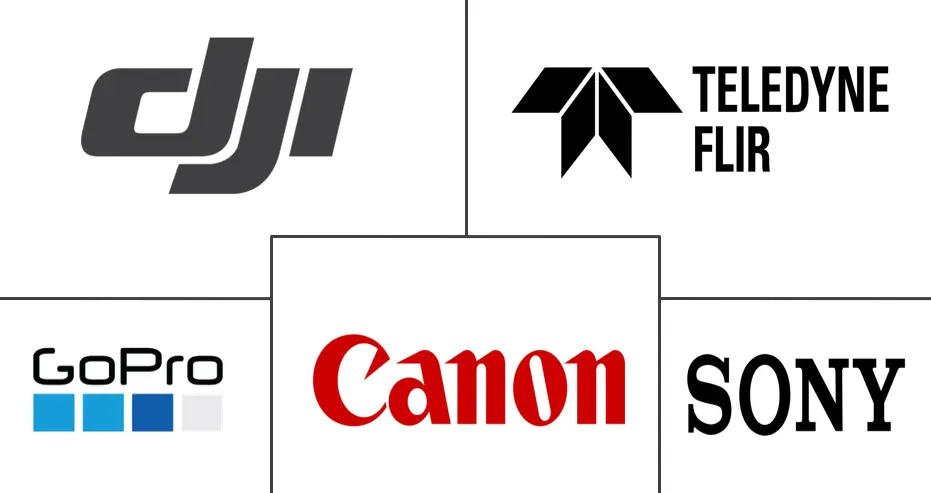Unmanned Aerial Systems (UAS) Camera Market Size and Share
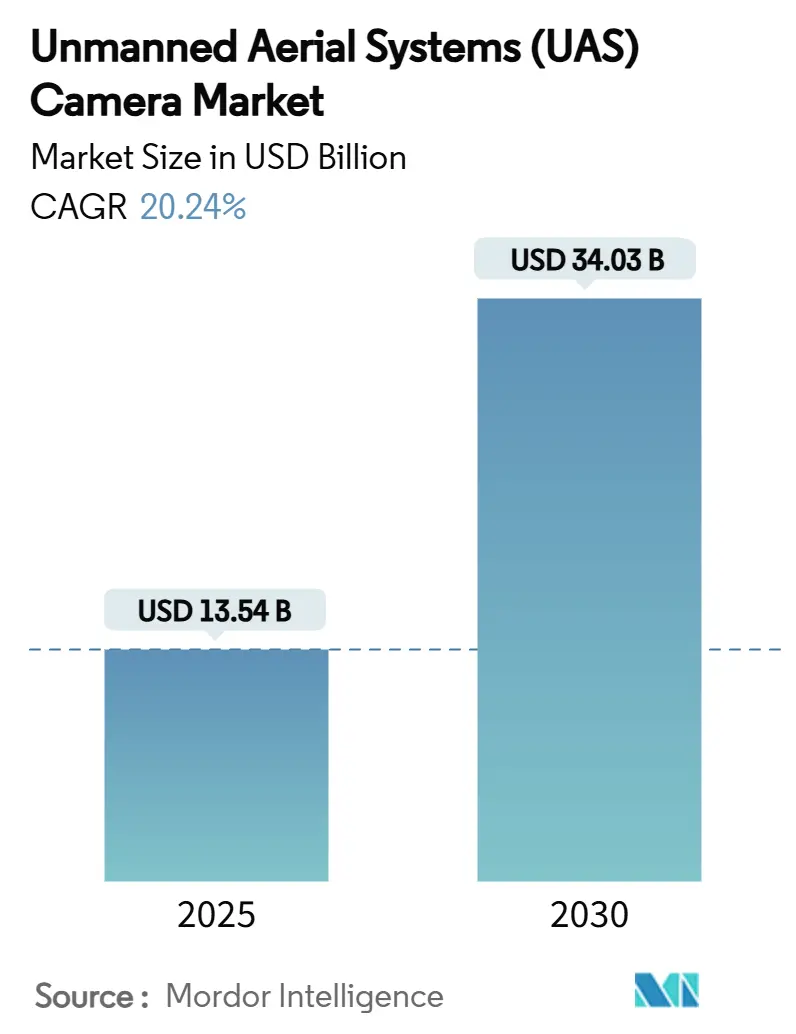
Unmanned Aerial Systems (UAS) Camera Market Analysis by Mordor Intelligence
The unmanned aerial systems (UAS) camera market size is estimated at USD 13.54 billion in 2025 and is forecasted to reach USD 34.03 billion by 2030, reflecting a 20.24% CAGR. This strong expansion is propelled by wider cross-sector adoption, rapid artificial intelligence (AI) integration, and regulatory pathways that ease routine beyond-visual-line-of-sight (BVLOS) flights. Manufacturers gain pricing power by embedding onboard edge-computing modules that execute real-time navigation and object-recognition tasks, trimming dependence on costly ground stations. Sovereign procurement agendas amplify domestic production, while Asia-Pacific supply chains balance cost and volume for global customers. Consolidation among legacy aerospace firms and specialist drone builders accelerates because incumbents need turnkey unmanned portfolios to defend market relevance. New entrants with AI-first architectures create additional competitive pressure as they shorten development cycles.
Key Report Takeaways
- By camera type, HD cameras led with 54.21% revenue share in 2024; thermal systems are advancing at a 21.67% CAGR through 2030.
- By application, photography and videography held 31.34% of the UAS camera market share in 2024, while thermal imaging is forecasted to expand at a 10.01% CAGR to 2030.
- By resolution, the 12 to 20 megapixel class accounted for 32.28% of the UAS camera market size in 2024, whereas the more than 32 megapixel class records the highest projected 10.86% CAGR through 2030.
- By end-user, commercial operators represented 46.54% share of total spend in 2024, yet homeland-security demand is rising at a 9.43% CAGR to 2030.
- By geography, North America commanded 33.27% of the market share in 2024, while Asia-Pacific is projected to expand at a 10.40% CAGR through 2030.
Global Unmanned Aerial Systems (UAS) Camera Market Trends and Insights
Drivers Impact Analysis
| Driver | ( ~ ) % Impact on CAGR Forecast | Geographic Relevance | Impact Timeline |
|---|---|---|---|
| Advancements in AI-enabled onboard image processing systems | +3.2% | North America, EU, Global expansion | Medium term (2-4 years) |
| Accelerated adoption of FPV drones in commercial cinematography | +2.1% | North America, EU, APAC rollout | Short term (≤2 years) |
| Declining cost of high-resolution CMOS imaging sensors | +2.8% | Global, APAC manufacturing hubs | Short term (≤2 years) |
| Government incentives driving precision agriculture UAS applications | +2.5% | North America, EU, emerging APAC | Medium term (2-4 years) |
| Emergence of SWaP-optimized thermal imaging cores for public safety UAS | +1.9% | Developed markets worldwide | Medium term (2-4 years) |
| Progress in satellite-to-UAS optical communications enabling BVLOS operations | +3.1% | Global, North American rulemaking | Long term (≥4 years) |
| Source: Mordor Intelligence | |||
Advancements in AI-enabled Onboard Image Processing Systems
Real-time edge computing converts drones from simple data gatherers into autonomous platforms that complete missions with minimal human oversight. A mission computer based on NVIDIA Jetson Orin NX, weighing under 300 g, now delivers 100 TOPS of neural-network performance, letting a small multirotor detect obstacles and re-route on the fly.[1]Neousys Tech, “Low-SWaP AI Mission Computer,” neousys-tech.com Energy-efficient deep-learning engines operating at 64 mW keep nano-UAS aloft longer, enabling economical crop-scouting, tower inspections, and hazardous-area reconnaissance. Platform vendors embedding these chips ship value-added services rather than raw airframes, enhancing switching costs for enterprise buyers. The resulting productivity gains widen use cases and pull fresh demand into the UAS camera market.
Accelerated Adoption of FPV Drones in Commercial Cinematography
First-person-view systems give directors crane-like shots inside warehouses or tight urban alleys at a fraction of helicopter budgets. US rules now permit night and over-people filming under Part 107 without special waivers, removing paperwork that once stalled indie productions. Production houses report savings near 70%, allowing even mid-tier studios to schedule multiple aerial sequences per shoot. The workflow shift enlarges addressable demand for ready-to-fly FPV rigs and positions accessory makers—goggles, digital links, motion controllers—to capture ancillary revenue inside the growing UAS camera market.
Declining Cost of High-resolution CMOS Imaging Sensors
Volume output from APAC fabs trims CMOS-sensor average selling prices by nearly 15% annually. Features like backside illumination and on-chip conversion drive noise down while protecting battery life, letting 20-megapixel payloads match the power draw of prior 12-megapixel units. Users now map farmlands in a single sortie instead of two, cutting labor hours and data-stitching fees. The virtuous cost cycle accelerates engineering, mapping, and smart-city surveillance deployments, reinforcing double-digit growth for the UAS camera market.
Government Incentives Driving Precision-Agriculture UAS Applications
Grants under the USDA Conservation Innovation program subsidize growers who trial imaging drones for nitrogen scheduling and soil-moisture tracking. Additional research awards from NIFA channel funds into sensor miniaturization and analytics engines linked to agronomic decision support. Smaller farms lacking capital now lease drone services delivered by rural cooperatives, broadening geographic penetration. Such policy levers push agricultural users to the front of the UAS camera market adoption curve over the next three seasons.
Restraints Impact Analysis
| Restraint | ( ~ ) % Impact on CAGR Forecast | Geographic Relevance | Impact Timeline |
|---|---|---|---|
| Rising costs associated with cyber-hardening and certification compliance | -1.8% | Global, stricter in North America and EU | Medium term (2-4 years) |
| Stricter export controls on dual-use electro-optical and infrared (EO/IR) payloads | -2.1% | US-China trade corridors | Short term (≤2 years) |
| Ongoing supply chain disruptions in critical imaging sensor components | -1.5% | APAC sourcing hubs | Short term (≤2 years) |
| Increasing legal challenges related to aerial biometric data collection | -1.2% | North America and EU | Long term (≥4 years) |
| Source: Mordor Intelligence | |||
Rising Costs Associated with Cyber-hardening and Certification Compliance
Manufacturers supplying defense or critical-infrastructure clients must align with the Cybersecurity Maturity Model Certification, adding 20-40% to engineering budgets for smaller firms.[2]Cybersecurity and Infrastructure Security Agency, “Cybersecurity Best Practices for Operating Commercial UAS,” cisa.gov Parallel avionics standards DO-178C and DO-254 impose additional documentation and independent verification expenses. While larger primes amortize these costs across multiple platforms, niche builders risk margin compression and may exit categories, nudging consolidation within the UAS camera market.
Stricter Export Controls on Dual-use Electro-optical and Infrared Payloads
Thermal cores and long-range zoom cameras face tighter licensing under ITAR and EAR regimes. The review process extends lead times, complicates international demos, and forces some vendors to maintain separate “export” and “domestic” configurations. Regional production spin-outs mitigate license delays but require fresh capital, raising break-even thresholds for newcomers. This drag modestly tempers the otherwise rapid UAS camera market expansion.
Segment Analysis
By Camera Type: Thermal Systems Gain Despite HD Dominance
In 2024, HD cameras represented 54.21% of the UAS camera market size, underscoring their affordability and ubiquity among general-purpose quadcopters. Thermal models, although newer, outpace all other categories at a 21.67% CAGR as utilities and fire departments mandate non-visual inspection protocols. Manufacturers combine visible and infrared sensors within single gimbals that weigh under 100 g yet deliver less than 50 mK NETD sensitivity, letting lightweight multirotors scan solar farms after sunset. Enterprise buyers prefer these hybrid payloads because a single sortie now yields photogrammetric mosaics and hotspot overlays, optimizing maintenance budgets. The trend persuades mid-tier suppliers to license micro-bolometer cores so they can enter the premium segment without lengthy R&D cycles.
Looking ahead, competitive advantage hinges on reducing total system weight while sustaining image fidelity across spectral bands. Firmware updates that fuse RGB and thermal pixels in real time appeal to inspectors who need actionable data on handheld devices minutes after landing. Such integrated features reinforce demand resiliency, helping thermal vendors capture incremental revenue inside the UAS camera market.
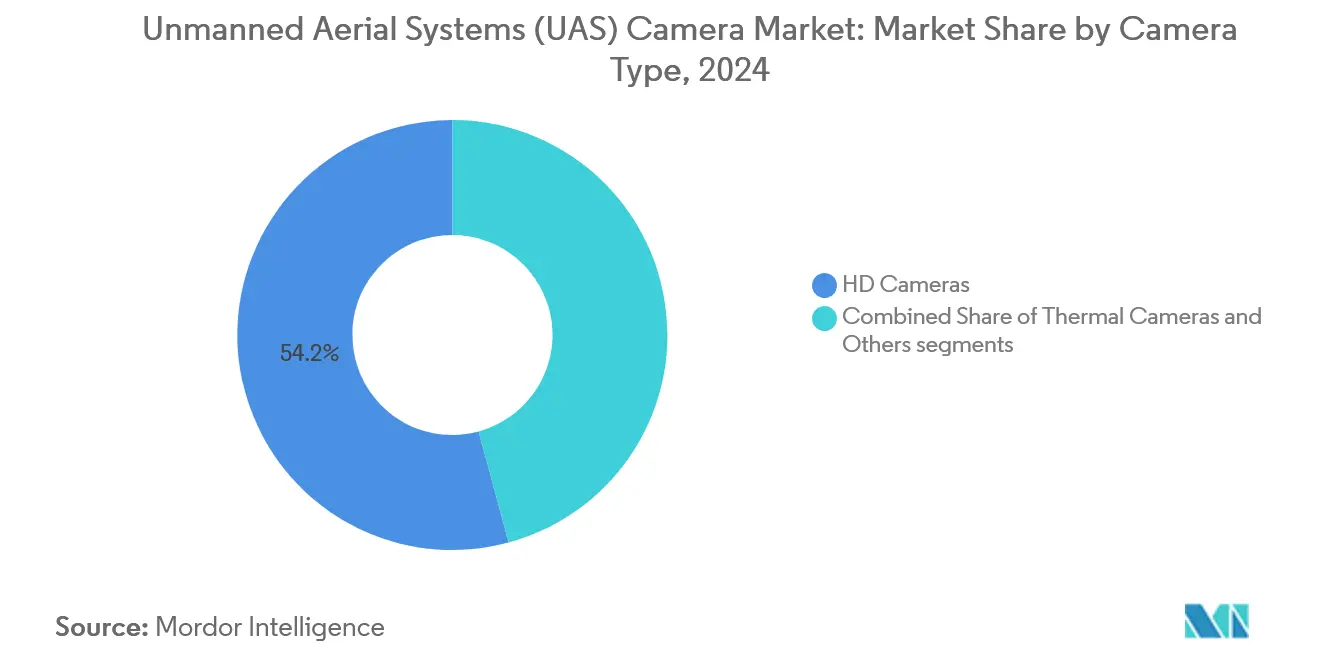
Note: Segment shares of all individual segments available upon report purchase
By Application: Thermal Imaging Accelerates Beyond Photography Dominance
Photography and videography applications retained 31.34% of overall spending in 2024, anchored by media, real-estate, and event-coverage routines familiar to most operators. Regulatory momentum toward standard BVLOS approvals unlocks fresh value in infrastructure inspection, where thermal cameras outperform RGB for leak and fault detection. Annual growth of 10.01% in thermal missions reflects this shift, with pipeline owners deploying drones to scan miles of remote assets without ground crews. Simultaneously, mapping and surveying platforms integrate auto-flight plans that trigger image capture at pre-set ground-sample distances, letting surveyors replace manned helicopters on mid-sized construction sites.
Application lines blur as a single multirotor equipped with modular payload bays alternates between filming, inspection, and mapping tasks by swapping sensors and updating mission scripts. Software-defined versatility pushes procurement toward fleets rather than bespoke airframes, lowering lifecycle operating expenses. Vendors who bundle mission-planning software, analytics, and regulatory compliance logs reinforce stickiness, magnifying revenue capture in the UAS camera market.
By Resolution: High-Resolution Growth Challenges Mid-Range Dominance
The 12 to 20 megapixel bracket captured 32.28% of 2024 revenue, serving as the default option for survey-grade orthomosaic generation when processing budgets are tight. Systems sporting over 32 megapixel chips expand at a 10.86% CAGR because ultra-fine detail shortens downstream manual-editing time in photogrammetry workflows. Backside-illuminated sensors paired with on-chip compression now shoot 48-megapixel stills while drawing comparable power to legacy 16-megapixel units, extending endurance without heavier batteries.
Low-altitude mapping operators who previously flew twice to hit the desired ground resolution now finish within one pass, freeing aircraft for additional assignments the same day. Meanwhile, under-12 megapixel configurations linger in training and hobby fields where cost per unit trumps analytical output. Resolution escalation is gradual because post-processing hardware must keep pace, but falling cloud-processing tariffs soften that barrier. Vendors offering scalable subscription analytics correlate raw-image size with automatic feature extraction, nudging buyers toward higher specification payloads and fueling expansion for the UAS camera market.
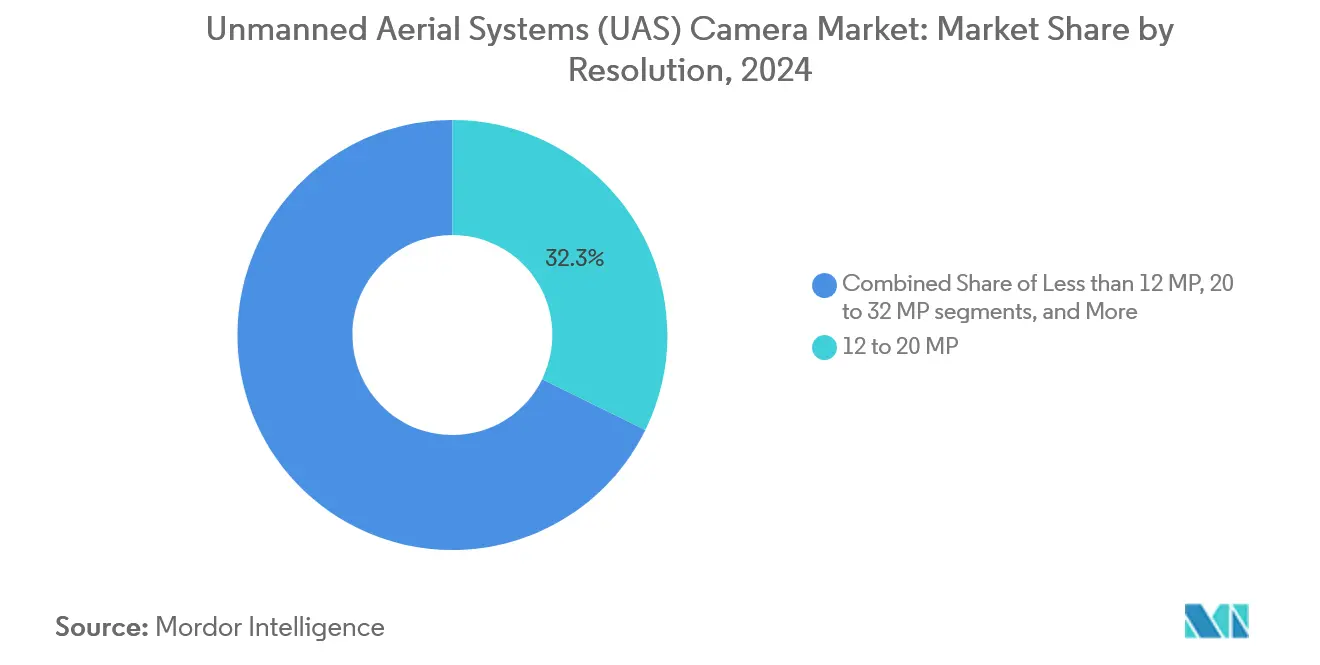
Note: Segment shares of all individual segments available upon report purchase
By End-user: Homeland Security Acceleration Challenges Commercial Leadership
Commercial operators held a 46.54% spending share in 2024, reflecting strong construction, agriculture, and content creation adoption. Homeland security agencies, however, invest aggressively in autonomous surveillance, pushing a 9.43% CAGR. Cities outfit fire brigades with rapid-launch quadcopters that relay thermal views of buildings before crews enter. Border-protection units deploy fixed-wing UAS swarms that verify alarms while patrol vehicles reposition.
Blue-UAS certification funnels procurement toward domestically produced systems and reshapes vendor pools. Simultaneously, military users adopt commercial off-the-shelf (COTS) cameras to cut costs, creating bidirectional technology transfer. Suppliers designing modular airframes satisfy civilian and defense checklists without redundant tooling, yielding economies of scale. The dual-use trajectory expands accessible revenue for UAS camera market participants.
Geography Analysis
North America contributed 33.27% to the UAS camera market size in 2024. FAA test-site programs, streamlined Part 107 waivers, and the USD 1 billion Replicator initiative channel consistent demand from civil and defense customers.[3]Federal Aviation Administration, “FAA BVLOS Drone Operations Report,” faa.gov State emergency-management agencies scale drone fleets for wildfire and hurricane response, generating recurring purchases of rugged thermal payloads. Canadian policy advances on BVLOS certificates extend commercial corridors over sparsely populated regions, benefiting resource-sector inspections.[4]Transport Canada, “Fly Your Drone Beyond Visual Line-of-Sight,” tc.canada.ca
Asia-Pacific is the fastest-growing cluster, registering a 10.40% CAGR to 2030. Economies like India deploy subsidy schemes that discount drone-sprayer hires for smallholder farms. China’s manufacturers supply more than 80% of civilian units worldwide, maintaining cost leadership, although export restrictions tighten in some segments. Local governments fund smart-infrastructure pilots integrating drones into road-bridge asset management, multiplying use-case diversity across the UAS camera market.
Europe records steady momentum, supported by EASA’s common rule set and member-state incentives for precision farming. Cybersecurity and privacy mandates create cost headwinds yet favor domestic manufacturers that provide verifiable data-handling chains. Research consortia bundle grants for hydrogen-fuel-cell propulsion and maritime-surveillance platforms, keeping regional know-how at the forefront. Cross-border cooperation on unmanned traffic-management prototypes aims to guarantee pan-EU scalability, strengthen export credentials, and sustain investment inflows.
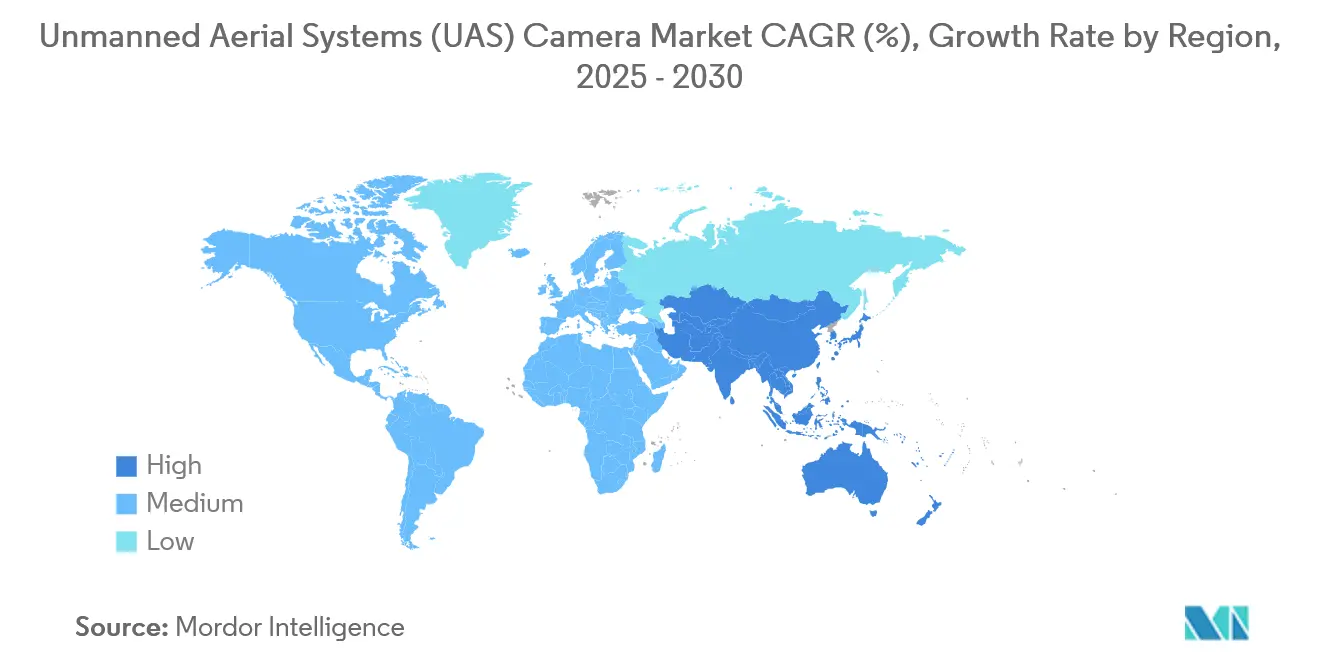
Competitive Landscape
The UAS camera market shows rising concentration as incumbent helicopter and fixed-wing OEMs buy nimble drone specialists to retain aerospace contracts. Robinson Helicopter’s purchase of Ascent Aerosystems added coaxial tactical drones to its catalog and transferred flight-safety expertise to the unmanned realm. Large primes partner with AI start-ups to embed autonomous stacks that reduce crew requirements, an approach visible in venture-backed software houses supplying navigation APIs for commercial and defense variants.
DJI remains dominant in civilian volumes, yet government buyers in the United States and parts of Europe pivot toward compliant alternatives certified under the Blue-UAS framework. Domestic vendors leverage secure supply chain credentials to penetrate public safety and defense verticals. Value migration shifts from airframes toward full-stack solutions encompassing maintenance, data analytics, and regulatory compliance dashboards. Vendors packaging fleet-management portals, encrypted cloud storage, and tailored training lock in customers for multi-year contracts. Competitive intensity, therefore, hinges less on raw flight time and more on software roadmaps and after-sales support. Companies combining hardware reliability with rapid firmware iterations will likely gain mid-term share in the UAS camera market.
Unmanned Aerial Systems (UAS) Camera Industry Leaders
-
Canon Inc.
-
Teledyne FLIR LLC
-
SZ DJI Technology Co., Ltd.
-
GoPro, Inc.
-
Sony Corporation
- *Disclaimer: Major Players sorted in no particular order
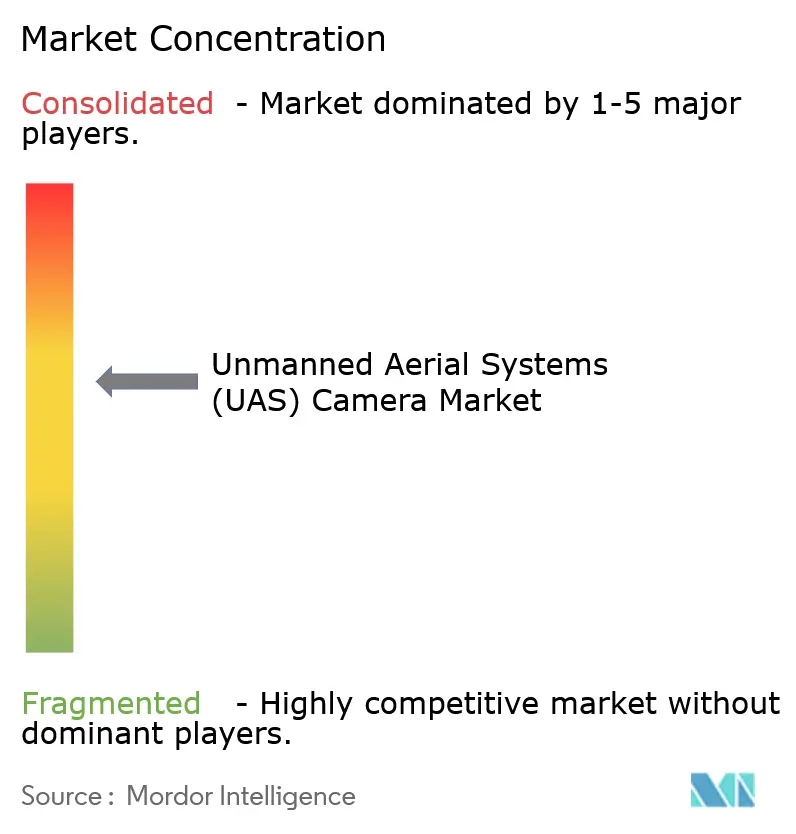
Recent Industry Developments
- July 2025: Auterion received a USD 50 million Pentagon contract to deliver 33,000 AI-driven drone strike kits to Ukraine, enhancing Ukraine's defense capabilities. The company's strike kits, featuring Skynode computers with integrated software, cameras, and radio modules, transform manual drones into autonomous systems capable of tracking targets within one kilometer while resisting interference.
- April 2023: Teledyne FLIR launched development kits to easily integrate the FLIR Hadron 640R thermal and visible dual camera module. The module’s compact radiometric Boson thermal camera grants visibility even in total darkness, smoke, and fog. It also features a 64MP electro-optical (EO) camera for high-definition visible imagery.
Global Unmanned Aerial Systems (UAS) Camera Market Report Scope
Unmanned aerial systems are equipped with a camera that can capture photographs and videos in various spectrums. It is integrated with sensors that enhance resolution and stabilize the system, including the flight path. It helps to provide an autonomous vision while reducing the need for physical inspection of the drone and its position in the sky. It also aids in other activities, including product and food delivery, surveillance over a small area, and thermal imaging. As a result, drone cameras can be found in a variety of industrial verticals worldwide.
The drone camera market is segmented by type, application, resolution, end-user, and geography. Based on the type, the drone camera market is segmented into SD cameras and HD cameras, by application into photography & videography, thermal imaging, and surveillance. By resolution, the market is segmented into 12 MP, 12 to 20 MP, 20 to 32 MP, and 32 MP & above. By end user, the market is segmented into commercial, military, and homeland security. The report also covers the market sizes and forecasts for the aircraft tire market in major countries across different regions. For each segment, the market size is provided in terms of value (USD).
| HD Cameras |
| Thermal Cameras |
| Others |
| Photography and Videography |
| Thermal Imaging |
| Surveillance |
| Mapping and Surveying |
| Inspection and Maintenance |
| Other Applications |
| Less than 12 MP |
| 12 to 20 MP |
| 20 to 32 MP |
| More than 32 MP |
| Commercial |
| Military |
| Homeland Security |
| North America | United States | |
| Canada | ||
| Mexico | ||
| Europe | United Kingdom | |
| France | ||
| Germany | ||
| Italy | ||
| Rest of Europe | ||
| Asia-Pacific | China | |
| India | ||
| Japan | ||
| South Korea | ||
| Australia | ||
| Rest of Asia-Pacific | ||
| South America | Brazil | |
| Rest of South America | ||
| Middle East and Africa | Middle East | United Arab Emirates |
| Saudi Arabia | ||
| Rest of Middle East | ||
| Africa | South Africa | |
| Rest of Africa | ||
| By Camera Type | HD Cameras | ||
| Thermal Cameras | |||
| Others | |||
| By Application | Photography and Videography | ||
| Thermal Imaging | |||
| Surveillance | |||
| Mapping and Surveying | |||
| Inspection and Maintenance | |||
| Other Applications | |||
| By Resolution | Less than 12 MP | ||
| 12 to 20 MP | |||
| 20 to 32 MP | |||
| More than 32 MP | |||
| By End-user | Commercial | ||
| Military | |||
| Homeland Security | |||
| By Geography | North America | United States | |
| Canada | |||
| Mexico | |||
| Europe | United Kingdom | ||
| France | |||
| Germany | |||
| Italy | |||
| Rest of Europe | |||
| Asia-Pacific | China | ||
| India | |||
| Japan | |||
| South Korea | |||
| Australia | |||
| Rest of Asia-Pacific | |||
| South America | Brazil | ||
| Rest of South America | |||
| Middle East and Africa | Middle East | United Arab Emirates | |
| Saudi Arabia | |||
| Rest of Middle East | |||
| Africa | South Africa | ||
| Rest of Africa | |||
Key Questions Answered in the Report
What is the current value of the Unmanned Aerial Systems (UAS) camera market?
The market stands at USD 13.54 billion in 2025 with a 20.24% CAGR outlook to 2030.
Which region leads in revenue contribution?
North America contributed 33.27% to the UAS camera market size in 2024.
Which camera type is gaining traction fastest?
Thermal systems are growing at a 21.67% CAGR due to public safety and inspection demand.
How are government programs influencing agricultural drone use?
USDA and NIFA grants lower adoption costs for growers, driving additional drone purchases.
What is the main challenge limiting export growth?
Dual-use sensor export controls increase compliance costs and delay shipments.
Page last updated on:
